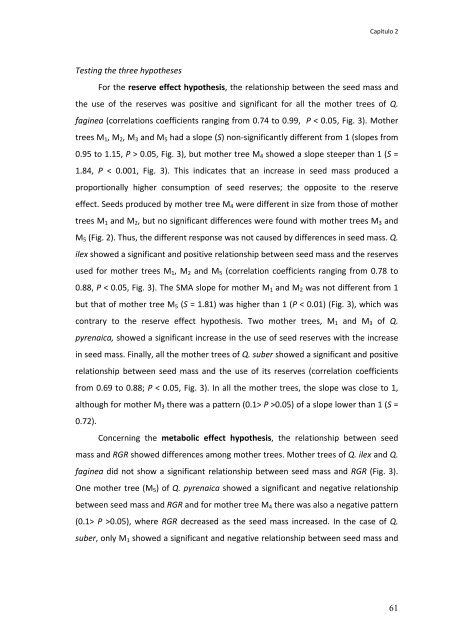Establecimiento de cuatro especies de Quercus en el sur de la ...
Establecimiento de cuatro especies de Quercus en el sur de la ...
Establecimiento de cuatro especies de Quercus en el sur de la ...
Create successful ePaper yourself
Turn your PDF publications into a flip-book with our unique Google optimized e-Paper software.
Capítulo 2<br />
Testing the three hypotheses<br />
For the reserve effect hypothesis, the r<strong>el</strong>ationship betwe<strong>en</strong> the seed mass and<br />
the use of the reserves was positive and significant for all the mother trees of Q.<br />
faginea (corr<strong>el</strong>ations coeffici<strong>en</strong>ts ranging from 0.74 to 0.99, P < 0.05, Fig. 3). Mother<br />
trees M 1 , M 2 , M 3 and M 5 had a slope (S) non‐significantly differ<strong>en</strong>t from 1 (slopes from<br />
0.95 to 1.15, P > 0.05, Fig. 3), but mother tree M 4 showed a slope steeper than 1 (S =<br />
1.84, P < 0.001, Fig. 3). This indicates that an increase in seed mass produced a<br />
proportionally higher consumption of seed reserves; the opposite to the reserve<br />
effect. Seeds produced by mother tree M 4 were differ<strong>en</strong>t in size from those of mother<br />
trees M 1 and M 2 , but no significant differ<strong>en</strong>ces were found with mother trees M 3 and<br />
M 5 (Fig. 2). Thus, the differ<strong>en</strong>t response was not caused by differ<strong>en</strong>ces in seed mass. Q.<br />
ilex showed a significant and positive r<strong>el</strong>ationship betwe<strong>en</strong> seed mass and the reserves<br />
used for mother trees M 1 , M 2 and M 5 (corr<strong>el</strong>ation coeffici<strong>en</strong>ts ranging from 0.78 to<br />
0.88, P < 0.05, Fig. 3). The SMA slope for mother M 1 and M 2 was not differ<strong>en</strong>t from 1<br />
but that of mother tree M 5 (S = 1.81) was higher than 1 (P < 0.01) (Fig. 3), which was<br />
contrary to the reserve effect hypothesis. Two mother trees, M 1 and M 3 of Q.<br />
pyr<strong>en</strong>aica, showed a significant increase in the use of seed reserves with the increase<br />
in seed mass. Finally, all the mother trees of Q. suber showed a significant and positive<br />
r<strong>el</strong>ationship betwe<strong>en</strong> seed mass and the use of its reserves (corr<strong>el</strong>ation coeffici<strong>en</strong>ts<br />
from 0.69 to 0.88; P < 0.05, Fig. 3). In all the mother trees, the slope was close to 1,<br />
although for mother M 3 there was a pattern (0.1> P >0.05) of a slope lower than 1 (S =<br />
0.72).<br />
Concerning the metabolic effect hypothesis, the r<strong>el</strong>ationship betwe<strong>en</strong> seed<br />
mass and RGR showed differ<strong>en</strong>ces among mother trees. Mother trees of Q. ilex and Q.<br />
faginea did not show a significant r<strong>el</strong>ationship betwe<strong>en</strong> seed mass and RGR (Fig. 3).<br />
One mother tree (M 5 ) of Q. pyr<strong>en</strong>aica showed a significant and negative r<strong>el</strong>ationship<br />
betwe<strong>en</strong> seed mass and RGR and for mother tree M 4 there was also a negative pattern<br />
(0.1> P >0.05), where RGR <strong>de</strong>creased as the seed mass increased. In the case of Q.<br />
suber, only M 1 showed a significant and negative r<strong>el</strong>ationship betwe<strong>en</strong> seed mass and<br />
61

















